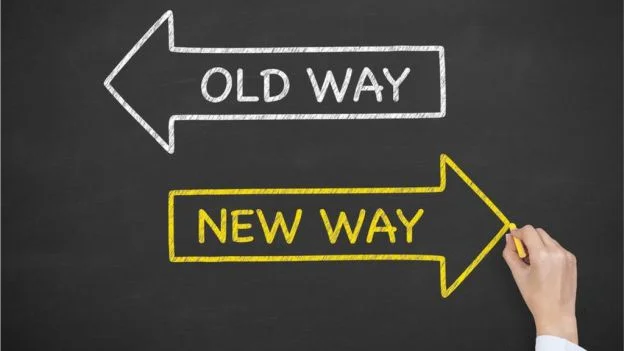by Leigh Ann Gowland, founder of Employee Driven Change
Managing change within corporates can be compared to changing the direction of an aircraft carrier set on its course with momentum, size and speed contributing to the resistance to any change in bearing. There is usually time to plan, mobilise the crew, and adapt to the weather conditions. By comparison a small business would be a canoe turned by a single paddle but also threatened by winds, currents and the strength of the oars-person.
Changing direction in calm conditions may be easier for a smaller vessel, unfortunately in rough weather the movement of the boat can be shifted by stronger external forces. Despite the obvious differences between large companies and small businesses, a unique and carefully managed change journey is vital to facilitating successful change in any context. Regardless of the change or business this article includes five tactics to navigating any change: clear vision, creating awareness, developing understanding, involvement in change, commitment to a path and building on stabilisation.
Envisage the destination
Early explorers, space travelers and adventurers generally start with a dream of a destination. Their journey begins with imagining a possibility of something new and exciting. A captivating vision of the possibilities engages the traveler and maintains focus when confronted with challenges and sceptics.
Your inspiration can originate from an idea, a frustration, a gap in the market, launch of a competitors offering or a business requirement for growth or efficiency. Irrespective of the impetus for change, creating a compelling picture of the future with detail, clarity and feeling will make the likelihood of realising the imagined change more attractive than the certainty of maintaining the status quo. Seeing a new reality from within the vision for the future arouses excitement, releases oxytocin to increase passion and belief in the possibility and serotonin to be positively motivate towards achieving the goal.
Preparing for the journey
Once the vision for change is clear, ask yourself: “How can I implement this change as quickly as possible and have the biggest impact?” Explore the nuances of the change from different perspectives to gain greater awareness of the change within the current context. “What should I already know?” “What can I learn and improve to guarantee the success of the change?” “What do I want to achieve at different stages of the change journey?” “Who can I involve in the change journey to collaborate and keep me accountable for implementation of the change?” Answers to these questions will help plan and prioritise the steps to be taken.
Explore different routes
Research similar changes in the market and gather knowledge from experts to gain an in-depth understanding of the enabling and opposing factors of the change. Talk to supporters, resistors and third parties to ascertain critical success factors and risks for implementing the change. Understanding the change in detail reduces anxiety by clarifying what’s most important to you, your team, your customers and partners and how the change will contribute to future success.
Embark on the journey
Choose a path and start the journey. Experiment by doing a small thing towards the achievement of the goal every day. Start with gaining sponsorship or mobilising a change champion support structure and each day take at least one action towards building the change. The process of exploring and experimenting may present unexpected challenges. These challenges provide an opportunity to test ideas, gather feedback, be creative, adapt your strategy and generate innovative solutions. Don’t move too quickly through this stage but take time to explore many paths and confront unresolved issues. Overcoming challenges and recognising positive outcomes will give you confidence in yourself and the possibility of success for the change.
Commit to a path
When the journey along a path provides consistent success towards the change start to close off escape routes and commit to a path that allows you to move forward. Evaluate each step on the path against the vision and commit to the reality. Let go of the previous situation and focus on what will be gained if you adopt the vision as the new reality.
After you have selected a set path, you may experience challenges that spark doubt and prompt you to return to the experimental stage of the journey. When you commit to a path consider involving an accountability partner with whom you discuss the options and identify the exact path to follow. Your accountability partner will help you maintain focus during times of doubts, remind you of your vision for change and your motivation to change.
It is widely accepted that the earth is round and space travel is possible. This is when the dream for change becomes an accepted reality. However, explorers continue to stretch the boundaries of travel building on the success of the brave explorers and continuously improving towards a new vision for the future.
When your change becomes a reality, celebrate the success of creating something new and embrace it as a carefully integrated part of the business. As a proven part of your business it becomes a foundation upon which you can continuously improve and launch new ideas. When you have a proven method for managing your changes use it to develop new realities because the journey is well worth the trip.
Leigh-Ann Gowland is the founder of Employee Driven Change, a coaching and consulting business in South Africa. Leigh-Ann has fifteen years experience in change management, human resources and work force transformation allowing her to understand change across industries, projects and corporate cultures. The different roles fulfilled in her fifteen year career from junior level administration, consultant, independent contractor, manager, volunteer to Executive management and small business owner has equipped her with an understanding of the dynamics of engaging stakeholders across different levels. Leigh-Ann's approach to consulting and coaching styles are informed by Systems Theory and her passion for empowering others to understand and drive change and apply these skills.
www.employeedrivenchange.co.za
More articles by Leigh-Ann...











